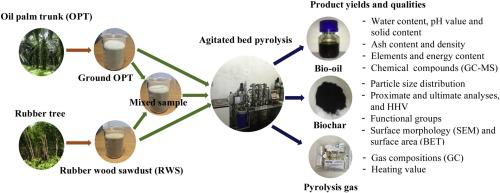Journal of Environmental Chemical Engineering ( IF 7.4 ) Pub Date : 2020-10-01 , DOI: 10.1016/j.jece.2020.104561 Patipan Sakulkit , Arkom Palamanit , Racha Dejchanchaiwong , Prasert Reubroycharoen

|
This study investigated the yields and characteristics of bio-oil, biochar and pyrolysis gas obtained from pyrolysis and co-pyrolysis of rubber wood sawdust (RWS) and oil palm trunk (OPT) by using an agitated bed pyrolysis reactor. Co-pyrolysis of RWS and OPT was performed at the mixing ratio of 50:50 (wt.). The biomass samples were pyrolyzed at temperatures of 400, 450, and 500 °C under specific conditions. The results indicated that the yields of the bio-oil, biochar and pyrolysis gas were in the ranges of 38.5-46.5, 22.27-28.68 and 30.1-36.9 wt.%, respectively. Pyrolysis of RWS at 500 °C provided the most bio-oil. Co-pyrolysis of RWS and OPT could improve the product yield and quality. The bio-oil had relatively high water content, while its pH was low. The main compounds of bio-oil were oxygenated compounds such as acetic acid, phenols and 2-Propanone, 1-hydroxy-, determined by GC-MS. The higher heating value (HHV) of bio-oil ranged from 16.1 to 20.36 MJ/kg. The biochar had high carbon content and low oxygen content in proximate and ultimate analysis, and based on FTIR. The HHV of biochar was in the range from 26.35 to 29.6 MJ/kg. The biochar also was highly porous, which was revealed by SEM and BET. The pyrolysis gas mainly contained CO, CO2, H2 and CH4, and its heating value was in the range from 3.23 to 6.7 MJ/m3. Based on these results, the RWS and OPT are alternative and challenging biomasses for conversion to biofuels and value-added products via pyrolysis.
中文翻译:

橡胶木和油棕树干生物质热解和共热解产生的热解产物的特性,用于生物燃料和增值应用
本研究研究了使用搅拌床热解反应器对橡胶木锯末(RWS)和油棕树干(OPT)进行热解和共热解得到的生物油,生物炭和热解气的产量和特性。RWS和OPT的共热解以50:50(wt。)的混合比进行。在特定条件下,将生物质样品在400、450和500°C的温度下热解。结果表明,生物油,生物炭和热解气的产率分别为38.5-46.5、22.27-28.68和30.1-36.9重量%。RWS在500°C的热解提供了最多的生物油。RWS和OPT的共热解可以提高产品的产量和质量。该生物油具有相对较高的水分含量,而其pH值较低。生物油的主要化合物是含氧化合物,例如乙酸,通过GC-MS测定苯酚和2-丙烷,1-羟基-。生物油的较高热值(HHV)为16.1至20.36 MJ / kg。根据FTIR,生物炭在最近和最终分析中具有高碳含量和低氧含量。生物炭的HHV在26.35至29.6 MJ / kg的范围内。生物炭也具有高度的多孔性,这通过SEM和BET显示。热解气主要含CO,CO2,H 2和CH 4,其发热量在3.23至6.7MJ / m 3的范围内。基于这些结果,RWS和OPT是替代品和具有挑战性的生物质,可通过热解转化为生物燃料和增值产品。











































 京公网安备 11010802027423号
京公网安备 11010802027423号